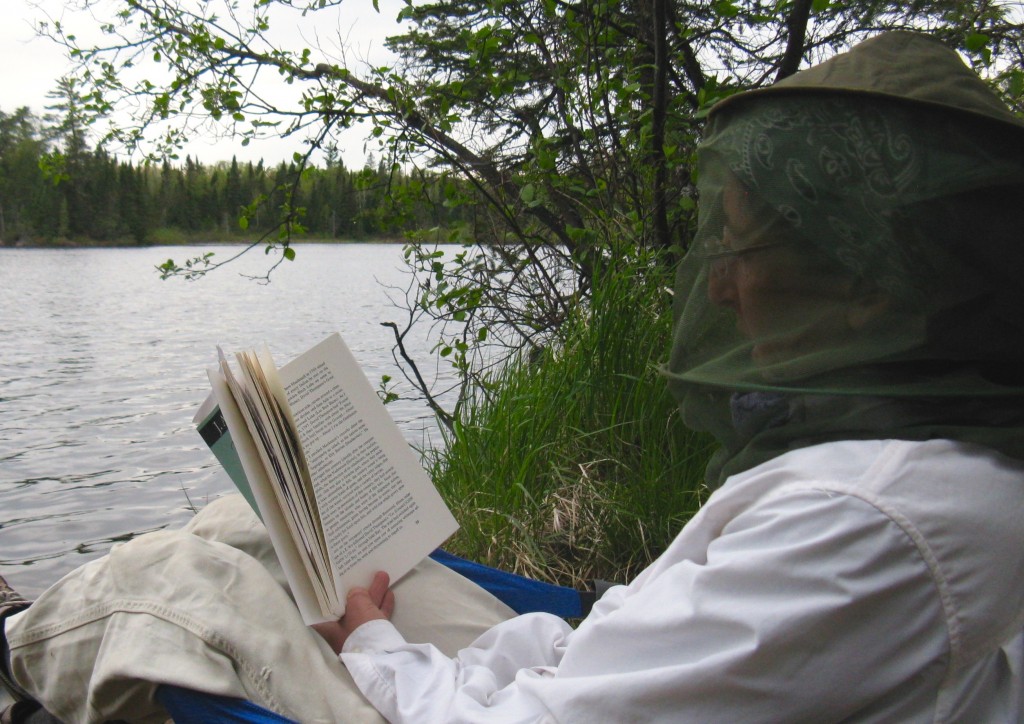Long time, no post. My move to fifth grade has been good for me, but the change in routine took a long, I mean, a long-long time to get used to. The bell marking the end of class was the crucial factor for me, which necessitated some pretty serious thinking about learning and how I fit into a system of bells and measured time. I may reflect on what the move taught me in subsequent posts.
For now, though, school’s out for summer, I’m back from a six-day paddle in the Boundary Waters Canoe Area Wilderness (BWCAW) in northern Minnesota, and I’m getting ready for a week-long workshop on inquiry-based science.
I’m reminded of how much I learn about the world and myself by just being outside for long stretches of time.
I wish I could take the kids out on a field trip to such a place as the BWCAW. We saw a moose feeding at the edge of the lake (how immense they are!); what appeared to be a lone trumpeter swan spend the afternoon in the bay, then trumpet and lift off a little after sunset; and many loons, like the ones in the video, who sang their mournful song at dusk.
We also saw mosses (my partner is teaching herself how to identify the different species), beautiful sedges in the woods, marshes, and along the lake edge, and the first flush of brilliant green aspen leaves against the darkness of the black spruce. Spring comes slowly to the north country.
We experienced several nights in the low 30s, the first black fly and mosquito hatch (oh boy!), and observed dragonfly larvae crawl from the cool lake waters, split open, then transform before our eyes. Even now, I have to catch myself. The dragonfly is BOTH the acrobatic aerialist who hunted mosquitoes gathered near my head AND the monstrous looking larva that crawls from the underwater world only to open and, like the crew members in the movie, Alien, disgorge a winged creature with a very long abdomen and a voracious appetite. Two worlds, two lives, one dragonfly.
Until you actually see the still-wet larva split open and the winged dragonfly emerge, life cycles are abstract ideas.
We pulled out for lunch on a piece of Canadian Shield (some of the oldest exposed rock in the world, the spine of the North American continent), then marveled at the work of the beaver, master builder, whose fur drew hordes of opportunists to the north country and became the tophats of the fashionable people in Europe.
Each night we read aloud an account of a canoe trip the author took in the 1950s that followed the old fur trade route from Grand Portage, MN to the Red River of the North.1 While not great literature, this book reminded me that what counts as a “good book” can be situational. Packed with first-hand accounts from the 18th and 19th centuries, I learned more about the Hudson’s Bay Company, the Northwest Company, the XY Company, and the homme du nord than I had known before. While our fare was meager, it was nothing like the 1 quart of lyed corn cooked with pork grease that was the daily meal during the trip: “All the food that a man needs for 24 hours on the road.”
Small comfort, though, that three hundred years ago the fur traders cursed the black flies and mosquitoes, too.

Beth reads our travel narrative aloud from under her bug net.
- Bolz, Portage into the Past. ↩

Lovely to hear your writing voice again, Steve. I have missed it. It makes me happy to think of you spending so much time outdoors. Warm wishes! Jan
Ditto.
Thank you so much for stopping by to read, Jan! It was a great trip. Good for the soul.
I hope that I can write more. I’ve missed it!
Are you going to NCTE in Minneapolis next year? I hope to get away again and make the trek north. T’would be great to see you again!
Oh, am I ever jealous (except for the black flies and mosquitoes)! Moose and loons are both still on my bucket list! And to see…to WITNESS…a dragonfly emerging!! Oh, be still my entomological heart!
Inquiry science. Looking forward to your learning. Like your musing on the bells, I want to know how that will fit in with The Standards.
It was a great trip. Somehow, I can imagine that you would really groove on a trip like this. I try to get out each year, but missed last year.
Last trip also coincided with the dragonfly hatch. Such a delight to see. One portage contained nearly a hundred in various stages of emergence. They are so fierce but so vulnerable until their wings dry. While watching one just emerged dragonfly, I saw several ants, many-many times smaller than the dragonfly, attack it while it could not move, scissor its head off, then carry both the head and the body away. The dragonflies emerged to catch the mosquitoes. The ants arrived to catch the dragonflies. Such a complex web of relationships. And none of these can be seen unless one waits and watches.